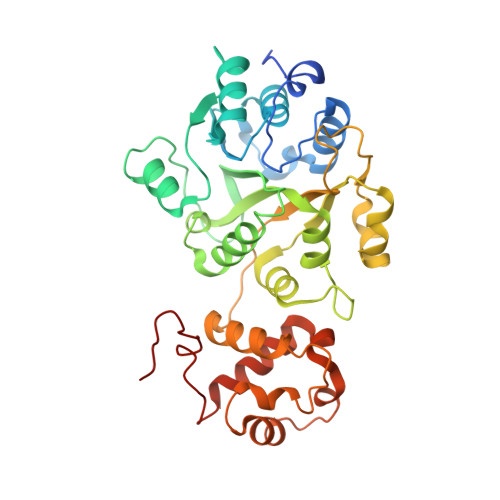Structures illustrate step-by-step mitochondrial transcription initiation.
Goovaerts, Q., Shen, J., De Wijngaert, B., Basu, U., Patel, S.S., Das, K.(2023) Nature 622: 872-879
- PubMed: 37821701
- DOI: https://doi.org/10.1038/s41586-023-06643-y
- Primary Citation of Related Structures:
8AP1, 8ATT, 8ATV, 8ATW, 8C5S, 8C5U, 8Q63 - PubMed Abstract:
Transcription initiation is a key regulatory step in gene expression during which RNA polymerase (RNAP) initiates RNA synthesis de novo, and the synthesized RNA at a specific length triggers the transition to the elongation phase. Mitochondria recruit a single-subunit RNAP and one or two auxiliary factors to initiate transcription. Previous studies have revealed the molecular architectures of yeast 1 and human 2 mitochondrial RNAP initiation complexes (ICs). Here we provide a comprehensive, stepwise mechanism of transcription initiation by solving high-resolution cryogenic electron microscopy (cryo-EM) structures of yeast mitochondrial RNAP and the transcription factor Mtf1 catalysing two- to eight-nucleotide RNA synthesis at single-nucleotide addition steps. The growing RNA-DNA is accommodated in the polymerase cleft by template scrunching and non-template reorganization, creating stressed intermediates. During early initiation, non-template strand scrunching and unscrunching destabilize the short two- and three-nucleotide RNAs, triggering abortive synthesis. Subsequently, the non-template reorganizes into a base-stacked staircase-like structure supporting processive five- to eight-nucleotide RNA synthesis. The expanded non-template staircase and highly scrunched template in IC8 destabilize the promoter interactions with Mtf1 to facilitate initiation bubble collapse and promoter escape for the transition from initiation to the elongation complex (EC). The series of transcription initiation steps, each guided by the interplay of multiple structural components, reveal a finely tuned mechanism for potential regulatory control.
- Laboratory of Virology and Chemotherapy, Rega Institute for Medical Research, KU Leuven, Leuven, Belgium.
Organizational Affiliation:





















